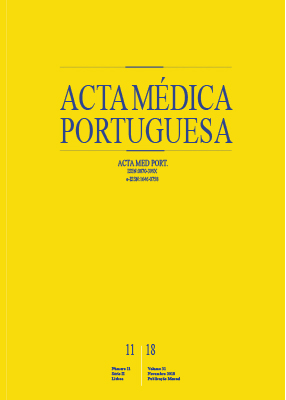Morbidity in Prematurity Associated with Fetal Growth Restriction: Experience of a Tertiary Care Center
DOI:
https://doi.org/10.20344/amp.9599Keywords:
Fetal Development, Fetal Growth Retardation, Infant, Premature, Small for Gestational Age, MorbidityAbstract
Introduction: Prematurity and low birth weight have been associated with increased neonatal morbidity and mortality. This study aimed to evaluate possible risk factors for prematurity associated with fetal growth restriction and being small for gestational age and to determine the incidence of morbidity in these two groups of infants.
Material and Methods: Retrospective case-control study of newborns with gestational age of less than 32 weeks, with obstetric diagnosis of fetal growth restriction and with the clinical diagnosis of small for gestational age, admitted to the Neonatal Intensive Care Unit of a tertiary hospital for a period of six years.
Results: A total of 356 newborns were studied, with an incidence of 11% of fetal growth restriction and 18% of small for gestational age. Pre-eclampsia was the risk factor for gestation with higher statistical significance (47% vs 16%, p < 0.001) in small for gestational age newborns. There was also a higher incidence of mild bronchopulmonary dysplasia (66% vs 38%, p = 0.005), late sepsis (59% vs 37%, p = 0.003), retinopathy of prematurity (58% vs 26%, p = 0.003) and necrotizing enterocolitis (20% vs 9%, p = 0.005). Mortality was similar in all three groups.
Discussion: There were fewer newborn males diagnosed with fetal growth restriction during pregnancy compared to women. Significant differences were observed in the group of these infants regarding the occurrence of chorioamnionitis and pre-eclampsia in comparison to the control group. Newborns with fetal growth restriction and small for age had higher scores on clinical risk indices compared to the control group. In general, small for gestational age newborns had a higher incidence of morbidity than infants with fetal growth restriction and the control group.
Conclusion: Advances in neonatal intensive care decreased mortality in preterm infants. However, there are still significant differences in the incidence of morbidity in newborns with growth compromise. The collaboration between obstetricians and neonatologists provides the basis for a correct clinical evaluation, early signaling and global intervention on these newborns, with a significant impact on short and long-term prognosis.
Downloads
Downloads
Published
How to Cite
Issue
Section
License
All the articles published in the AMP are open access and comply with the requirements of funding agencies or academic institutions. The AMP is governed by the terms of the Creative Commons ‘Attribution – Non-Commercial Use - (CC-BY-NC)’ license, regarding the use by third parties.
It is the author’s responsibility to obtain approval for the reproduction of figures, tables, etc. from other publications.
Upon acceptance of an article for publication, the authors will be asked to complete the ICMJE “Copyright Liability and Copyright Sharing Statement “(http://www.actamedicaportuguesa.com/info/AMP-NormasPublicacao.pdf) and the “Declaration of Potential Conflicts of Interest” (http:// www.icmje.org/conflicts-of-interest). An e-mail will be sent to the corresponding author to acknowledge receipt of the manuscript.
After publication, the authors are authorised to make their articles available in repositories of their institutions of origin, as long as they always mention where they were published and according to the Creative Commons license.









